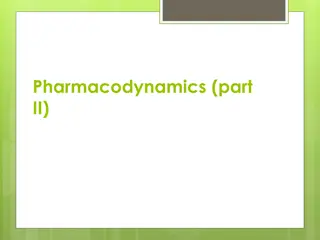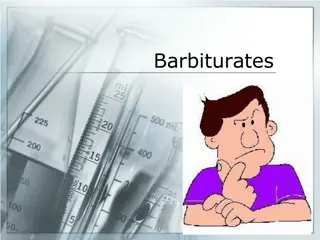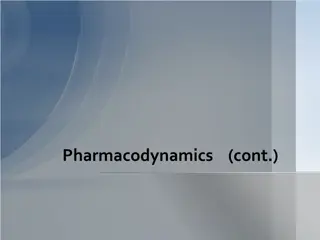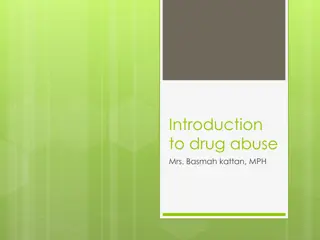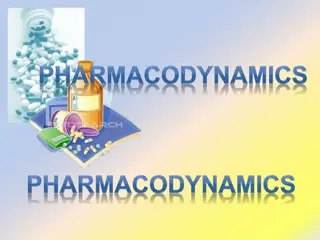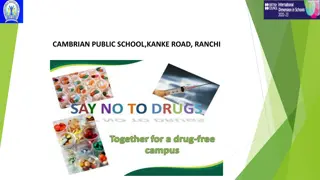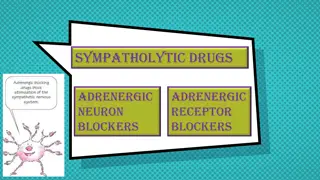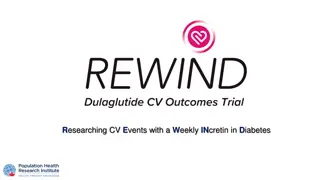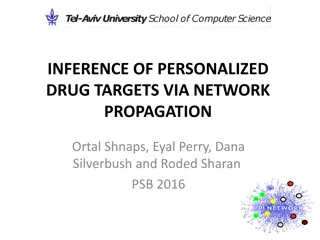Understanding Drug Action Mechanisms and Receptor Targets
Pharmacodynamics involves studying the effects of drugs on biochemical and physiological levels, focusing on drug actions through receptor-mediated and non-receptor mechanisms. The interaction between drugs and targets like proteins and enzymes impacts cellular functions. Different binding forces, such as ionic and covalent bonds, influence drug-receptor interactions, affecting processes like microtubule formation for treatments like gout and cancer. Receptors, enzymes, ion channels, and carrier molecules play crucial roles in drug actions by modulating cellular responses.
Download Presentation

Please find below an Image/Link to download the presentation.
The content on the website is provided AS IS for your information and personal use only. It may not be sold, licensed, or shared on other websites without obtaining consent from the author. Download presentation by click this link. If you encounter any issues during the download, it is possible that the publisher has removed the file from their server.
E N D
Presentation Transcript
mechanism of drug action Objectives: Identify different targets of drug action Differentiate between their patterns of action; agonism versus antagonism Elaborate on drug binding to receptors Success consists of going from failure to failure without loss of enthusiasm Contact us : Pharma436@outlook.com @Pharma436 1
What is Pharmacodynamics? Pharmacodynamics is a branch of pharmacology that deals with the study of the biochemical and physiological effects of drugs and their mechanisms of action at cellular and organ level . the mechanisms of drug action : 1- Binding with a biomolecule(receptor- mediated mechanisms) 2- Non receptor-mediated mechanisms Biomolecules = Targets=Receptors Mostly protein in nature (protein target). Physiochemical properties of drugs. Protein targets for drug binding : Structural protein Regulatory proteins Physiological receptors Enzymes Ion channels Carriers Chemical action E.g. Neutralization of gastric acidity by antacids. Physical action E.g. Osmotic diuretics. Purgatives used in treatment of constipation e.g. MgSO4 What are targets for drug binding ? Drug receptor- mediated mechanism Non receptor- mediated mechanisms Drug actions Contact us : Pharma436@outlook.com @Pharma436 2
Protein (target) Regulatory (regulate specific process inside the cell) structural Carrier molecule Ion enzyme receptor channel Binding forces between Drugs andReceptors: 1. IonicBond 2. Van-Dar-Waal 3. HydrogenBond 4. CovalentBond (the strogest bond) e.g. tubulin which is required for microtubules formation Structural protein Protein Tubulin is a target for Anti gout drugs anticancer drug E,g, Colchicine (used in treatment of gout ) e.g. Vincristine (anticancer agent ) Colchicine binds to tubulin and inhibits the formation of microtubules, preventing neutrophil motility and decreasing the inflammation. Vincristine kills cancerous cells by inhibiting microtubule formation and cell division Contact us : Pharma436@outlook.com @Pharma436 3
Receptor-mediated mechanisms: Receptors : Is a special macromolecule that binds the drug and mediates its Pharmacological action responsible for selectively sensing and binding of a stimulus (ligand) And its coupling to a response via a set of signal transduction machinery location of the receptors: cell membrane cytoplasm nucleus Enzymes : The drug competes with the natural endogenous substrate for the enzyme E.g. Anticholinesterases. reversible : Neostigmine reversibly compete with ACH for acetyl cholinesterase enzyme at motor end plate (neuromuscular junction) Irreversible: Organophosphates irreversibly competes with ACH for acetyl cholinesterase Ion channels : Drugs bind to alter channel function (by opening or blockade). Channels are responsible for influx or out-flux of ions through cell membranes along their concentration gradients They are activated by alteration in action potential and are controlled by gating mechanisms Blockers : Local anesthetics (block the pain during operation on the patient) Block Na influx through Na channel in Nerve fibers. They are Na channel blockers modulation : Sulfonylurea drugs (use for treatment type 2 diabetes To secrete insulin Block K+ out-flux via the K channels in pancreatic cells. They are K channels modulator . Carrier molecule: The drug binds to such molecules altering their transport ability Responsible for transport of ions and small organic molecules between intracellular compartments, through cell membranes or in extracellular fluids. e.g., Na+ , K+-ATPase inhibitor Digoxin: blocks Na efflux via Na pump; used in treatment of heart failure. Cocaine: blocks transport or reuptake of catecholamines (dopamine) at synaptic cleft The dopamine transporter can no longer perform its reuptake function, and thus dopamine accumulates in the synaptic cleft. Contact us : Pharma436@outlook.com @Pharma436 4
Pictures for more understanding: Anticholinesterases (antiacetylase) In the normal, the Ach leaves the pre-synaptic neuron to post-synaptic of muscle cell, at the synapse there is enzyme (Ach esterase) will metabolize some of the Ach and degenerate it, when we use drug which is Anticholinesterases it will bind to the Ach esterase and inhibit it, so there will be accumulation of the Ach Effect of cocaine In the normal, the dopamine leave the neuron and some of the dopamine binds with the receptor (the Purple in the picture) and produce effect, and some of the dopamine will reuptake by the transporter (the green in the picture) . If the patient uses cocaine the cocaine will inhibit the transporter so the dopamine will not reuptake and all the receptors will be bind with dopamine which will give high dopamine effect Contact us : Pharma436@outlook.com @Pharma436 5
Terms definition: The definition Other definition Explanation The term Ability of a drug to combine with the receptor. is the capacity of a drug to form a complex with the receptor(DR complex) D + R D-R complex Effect. * *D = drug , R = receptor Affinity Capacity of a drug receptor complex (D- R) to produce an action. is the maximal response produced by a drug (E max). the ability of the drug once bound to the receptor to trigger response The value of intrinsic activity (efficacy) ranges from 0 to 1 ( the intrinsic activity of antagonist drugs is 0 e.g. atropine) Efficacy (Intrinsic Activity) is a drug that combines with receptor and elicit a response (affinity + efficacy). Agonist - is a drug that combines with a receptor without producing responses. It blocks the action of the agonist (has affinity but no or zero efficacy). having full affinity to the receptor but no intrinsic activity(0) e.g. atropine Antagonist having a full affinity to the receptor and Affinity is the capacity of a drug to form a maximal intrinsic activity (1) e.g. acetylcholine Full agonist - - having a full affinity to the receptor but with low intrinsic activity (<1) e.g. pindolol Partial agonist - - Contact us : Pharma436@outlook.com @Pharma436 6
Agonist Full agonist Partial agonist A drug that combines with its specific receptor to produce maximal effect by increasing its concentration (affinity & high efficacy). e.g.ACh combines with its receptor & evokes a response as a full agonist but produces submaximal effect regardless of concentration (affinity & partial efficacy). e.g. pindolol a beta blocker which is a Partial agonist produce less decrease in heart rate than pure antagonists such as propranolol. The value of intrinsic activity (efficacy) ranges from 0 to 1 ( the intrinsic activity of antagonist drugs is 0 e.g. atropine) The full agonist has the maximal effect (1), and after it reaches to the maximal effect there will be no increasing in the effect (constant( The partial agonist will have effect (Efficacy ) but it will not reach to the maximal effect (1) but it has its own maximal effect, and when the partial agonist reach to its own maximal effect there will be no increasing in the effect (constant( Contact us : Pharma436@outlook.com @Pharma436 7
Quick exam https://www.onlineexambuilder.com/p harmacology-l5/exam-109362 Contact us : Pharma436@outlook.com @Pharma436 8
Pharmacology Team : Boys Girls Contact us : Pharma436@outlook.com @Pharma436 9


